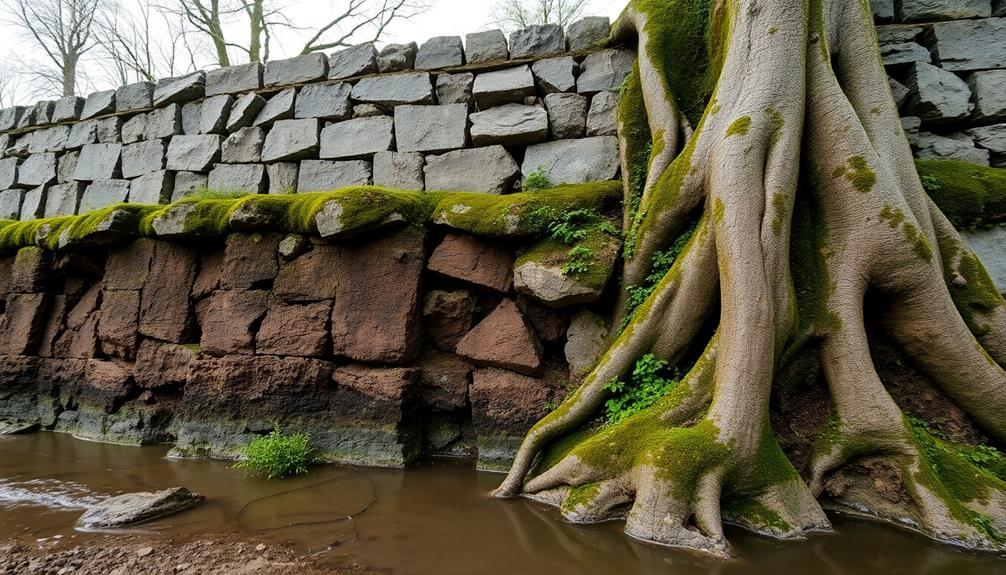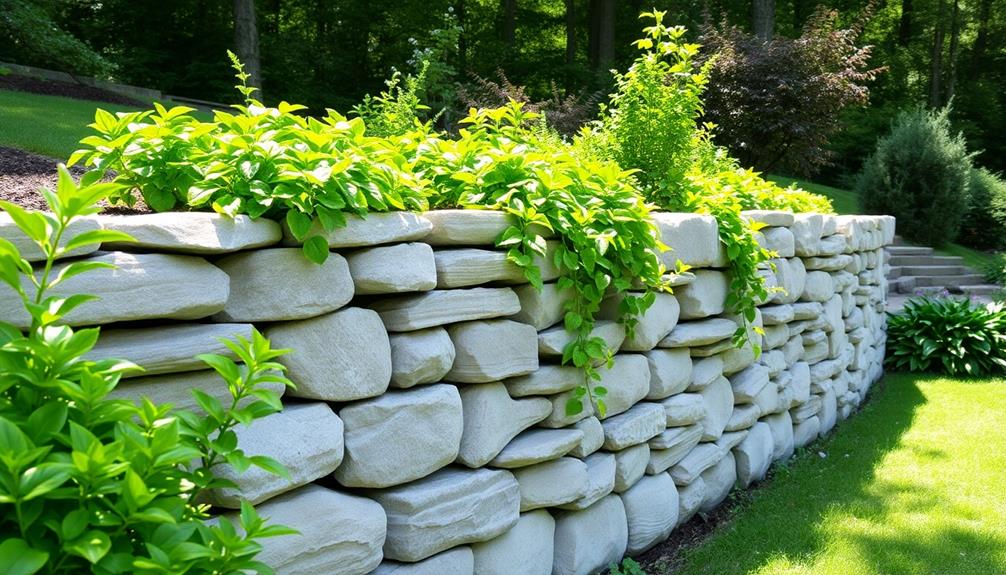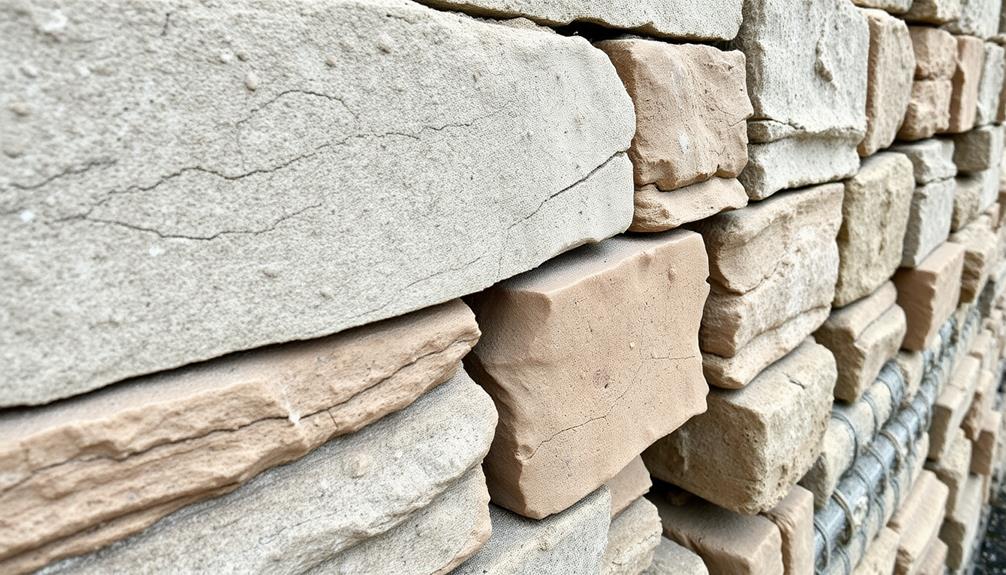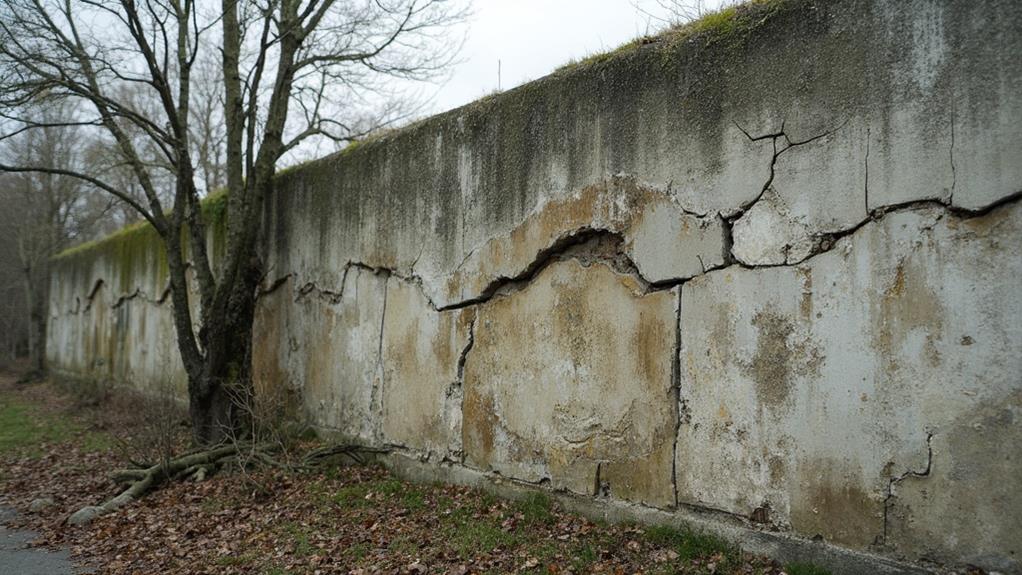To identify common issues in retaining walls, focus on signs of improper drainage management, inadequate structural design, and poor construction materials. Improper drainage may lead to hydrostatic pressure buildup, causing tilting or cracking if not mitigated by weep holes and adequate backfill. Inadequate structural design can result from neglect in appraising soil composition, slope, and external forces, compromising integrity. Additionally, using substandard materials like unsuitable aggregates or unreliably reinforced concrete can cause premature deterioration. Attention to these factors can prevent costly damages and safeguard stability. Exploring each aspect further will provide essential insights into maintaining wall functionality and longevity.
Table of Contents
ToggleWalls Contractor Highlights
- Look for visible cracks or leaning which may indicate structural weakness or pressure imbalance.
- Check for improper or absent drainage features such as weep holes and gravel backfill.
- Observe any soil erosion or puddling around the wall indicating drainage issues.
- Examine the material condition for any signs of deterioration or substandard quality.
- Inspect for water seepage or moisture accumulation, suggesting inadequate waterproofing or drainage.
Causes of Wall Failure

The failure of retaining walls is often attributed to several critical factors, including improper drainage management, which can lead to water accumulation and increased lateral pressure on the wall structure. Insufficient drainage can also result in erosion, further destabilizing the structure.
Inadequate structural design is another culprit, as it may not sufficiently account for the various forces and environmental conditions that the wall must withstand, leading to structural instability and eventual collapse. In addition, the use of poor construction materials can compromise the wall's integrity over time, as they might not possess the necessary strength or durability to consistently withstand weather conditions and soil pressure. This is why it is important for retaining walls to utilize robust materials like boulders, which provide a long-lasting and cost-effective solution.
Improper Drainage Management
One of the leading causes of retaining wall failure is improper drainage management. Effective drainage is indispensable, as it prevents the accumulation of hydrostatic pressure behind the wall. When water is not efficiently redirected away from the wall, it exerts an immense force on the structure, compromising its stability. This can lead to undesirable consequences such as wall tilt, cracking, or complete collapse.
The failure to install adequate drainage systems, such as weep holes, drainage pipes, and gravel backfill, can exacerbate these risks. These components collectively function to manage water flow, ensuring it does not collect around the wall, thereby reducing pressure and maintaining the wall's integrity. Alongside drainage installations, the selection of soil type plays a pivotal role in the wall's performance. Permeable soils like gravel encourage water movement, whereas clay soils tend to retain moisture, elevating hydrostatic pressure levels.
Communities and property owners can benefit from recognizing and addressing these drainage-related issues early on. Consulting with an experienced professional can provide tailored solutions that align with specific site conditions, thereby preserving not only the physical structure but also the sense of safety and security essential to the community's wellbeing.
Inadequate Structural Design
While improper drainage is a common culprit, inadequate structural design is another major factor contributing to retaining wall failures. Fundamentally, retaining walls require an engineering approach that takes into account various geological and environmental conditions. Failure to appropriately calculate lateral earth pressures or neglecting to integrate a sufficient factor of security can result in structures that are deficient from inception.
To guarantee structural integrity, a meticulous analysis of soil composition, slope gradient, and seismic activity is essential. Without these considerations, walls may bear loads they were not originally designed for, leading to potential structural compromises.
When examining the intricacies of design, it is indispensable to prioritize proper weight distribution and accommodate natural forces such as hydrostatic pressure. A sound structural design incorporates reinforcements and selects shapes and materials that offer optimal stability. Unreinforced designs or those failing to utilize counterfort, gravity, or cantilevered models might succumb under stress.
For design to serve its purpose, holistic integration of site-specific factors must be employed. By aligning engineering practices with the unique characteristics of each project site, the community can guarantee longevity and safety in their retaining structures, fostering a sense of security and belonging within shared spaces.
Poor Construction Materials
In the domain of retaining wall construction, the selection of materials plays a pivotal role in determining overall durability and performance. A community's confidence in a lasting infrastructure often rests on the careful choice of construction materials, which must withstand both environmental pressures and time.
Poor construction materials can be a primary cause of wall failure, undermining the structural integrity that communities rely on. When inferior materials are used, they can lead to premature deterioration, causing issues such as cracking, leaning, or even collapse.
Inadequate material selection typically involves the use of substandard concrete, inappropriate aggregates, or unsuitable reinforcement materials. These choices fail to meet the essential criteria for longevity, especially when exposed to fluctuating climates or erosion-prone areas. Quality control lapses may also result from a lack of adherence to regional standards or improper material testing prior to construction.
Over time, these deficiencies manifest as compromised strength and unforeseen maintenance costs, challenging the collective safety and aesthetic aspirations of any community.
To mitigate these risks, it is critical to employ rigorous material assessment protocols, ensuring that every component meets or exceeds established engineering standards. By doing so, the sustainability and resilience of retaining walls can be markedly enhanced.
Benefits

The integration of retaining walls within a property not only enhances structural stability by effectively managing soil and preventing erosion but also augments the aesthetic appeal, contributing to a more visually pleasing landscape. This, in turn, can lead to an elevation in property value as potential buyers often place a premium on such enhancements.
Boulder walls offer a unique, rustic look that complements natural settings, providing further customization and enhancement. Additionally, well-constructed retaining walls can reduce long-term maintenance costs by minimizing land degradation and associated repair requirements.
Improved Structural Stability
Enhanced structural stability in retaining walls offers significant benefits that extend beyond mere functionality. A well-constructed retaining wall not only effectively holds back soil but also fortifies the integrity of a property by guaranteeing safety through its design and execution. This structural soundness reduces the risk of soil erosion and land movement, key factors in safeguarding both residential and commercial developments.
Stability in retaining walls provides peace of mind, fostering a sense of security and assurance for property owners and communities alike.
Furthermore, improved structural stability contributes to the longevity of the wall. Employing high-quality materials and expert craftsmanship during construction results in a durable barrier capable of withstanding weathering and environmental pressures over time. This commitment to excellence not only minimizes maintenance costs but also enhances the overall value of the premises by preventing costly damage or the need for premature replacement.
Importantly, retaining walls with enhanced structural stability guarantee a safe and accessible environment, imperative for public areas or private gardens where people gather. By focusing on enduring strength and reliable performance, these walls support a sense of place and belonging, underpinning the shared spaces where communities thrive and connect.
Enhanced Aesthetic Appeal
Beyond the robust functionality offered by improved structural stability, retaining walls also provide significant benefits with respect to aesthetic appeal. They can transform a mundane landscape into a visual spectacle while serving essential functional roles, ensuring that properties are not only protected but also admired. Integrating visually appealing materials and design elements creates a cohesive look that harmonizes with the surrounding environment, fostering a sense of belonging within a community.
To truly enhance the aesthetic value of retaining walls, consider the following elements:
- Material Selection: Opt for natural stones, bricks, or modern concrete finishes to complement the existing architectural theme of your property, ensuring visual coherence.
- Color Coordination: Employ a palette that resonates with the landscape, creating a seamless blend between the wall and its environment, evoking a welcoming and unified feel.
- Textural Variety: Incorporate different textures through layered designs or the incorporation of plant life to add depth and interest to the structure, further enhancing its visual appeal.
- Design Innovation: Infuse artistic designs or patterns that reflect personal or local cultural aesthetics, transforming a functional structure into a distinctive piece of art.
Increased Property Value
Investing in retaining walls can greatly boost your property's marketability and financial worth. By addressing topographical challenges, retaining walls transform previously unusable or underutilized land into functional and attractive spaces, subsequently enhancing the overall perception of the property. This strategic investment not only facilitates effective land use but also potentially increases the square footage of usable land, directly contributing to an elevated property value.
Additionally, expertly designed retaining walls can serve as the cornerstone for a harmonious landscape, enriching the exterior's aesthetic cohesiveness and attracting potential buyers who value both practicality and visual appeal.
Moreover, retaining walls play a pivotal role in mitigating soil erosion, safeguarding the structural integrity of your property. This protection can prevent costly damage that may diminish property value over time. When potential buyers perceive a property as structurally sound and aesthetically pleasing, they are more inclined to pay a premium.
Consequently, property owners choosing to integrate retaining walls are likely to witness a favorable return on investment, not just in enhanced property appeal, but in tangible financial appreciation. In other words, retaining walls are not merely functional fixtures but strategic enhancements that align with long-term property value growth aspirations.
Reduced Maintenance Costs
By incorporating retaining walls into your landscape design, property owners can substantially reduce long-term maintenance costs. These structures provide significant stability to sloped areas, minimizing soil erosion and water-related damage, which otherwise could necessitate frequent, expensive repairs.
Not only do they present a strategic investment for maintaining the aesthetic and structural integrity of your property, but they also offer a range of specific maintenance benefits.
- Erosion Control: Retaining walls effectively inhibit soil erosion by securing the soil in place, which decreases the chance of costly landscape repairs and the need for labor-intensive soil restoration projects.
- Water Management: By managing water flow and preventing pooling, retaining walls decrease water damage expenses. Proper drainage systems integrated into these walls reduce excess water-related issues, cutting the need for additional maintenance.
- Durability: Constructed from robust materials such as concrete or stone, these walls require minimal upkeep, reducing the annual upkeep costs associated with traditional landscaping solutions.
- Aesthetic Longevity: Retaining walls enhance the visual appeal of your property over time, negating the necessity for frequent cosmetic updates, and ensuring a consistent look that blends with the community's landscape aesthetic.
These advantages illuminate how retaining walls serve as a cornerstone for both financial and environmental sustainability in landscape management.
Construction Material Considerations

When considering the construction of retaining walls, selecting materials that offer resilience is paramount, particularly given the varied impacts that climate can exert on these materials, ranging from freeze-thaw cycles to intense heat exposure, thereby influencing the longevity and performance of the structure. Additionally, the importance of integrating effective waterproofing techniques cannot be understated, as these methods serve to substantially reduce water infiltration, which can lead to potential structural failures. To aid in understanding the implications of these factors, the table below outlines key considerations in material selection for retaining walls.
| Consideration | Explanation | Importance Level |
|---|---|---|
| Durable Materials | Essential for long-lasting structural integrity | High |
| Climate Impact | Influences material performance over time | Medium |
| Waterproofing Techniques | Prevents water-related damage and erosion | High |
Choosing Durable Materials
Selecting the right materials for a retaining wall is vital to guarantee its longevity and structural integrity. Each material offers distinct advantages and challenges that professionals need to ponder based on the project's specifications, ensuring a well-built structure that aligns with communal needs and aspirations.
Concrete Blocks: Known for their strength and versatility, concrete blocks provide a robust solution that can be easily customized to fit various design requirements. Their durability against pressure makes them a popular choice in community projects where long-term dependability is crucial.
Natural Stone: While aesthetically pleasing and naturally durable, working with natural stone demands skilled craftsmanship. This material favors settings that wish to blend functionality with traditional or rustic aesthetics, offering a timeless character that unites past and present.
Treated Timber: Economical and relatively simple to install, treated timber brings an organic touch to retaining walls. However, its lifespan can be shorter than other materials, making it more suitable for temporary or decorative applications within community spaces.
Brick: Offering a classic appeal, brick combines resilience with design flexibility. Its structured appearance complements both modern and historic environments, encouraging a sense of permanence and unity in residential layouts.
Selecting suitable materials demands a balance between immediate needs and enduring community value, highlighting the importance of informed decision-making.
Climate Impact on Materials
The choice of materials for a retaining wall is profoundly influenced by the project's climatic conditions, substantially impacting the wall's performance and durability. In regions with high humidity or frequent rainfall, materials like concrete and stone are preferred for their resistance to moisture-related degradation.
Conversely, in arid or fluctuating climates, selecting materials adept at handling thermal expansion, such as treated timber or well-reinforced concrete, becomes essential. These choices guarantee that the wall stands resilient against the stresses imposed by temperature variations that can lead to cracking or warping.
For those residing in areas prone to freezing and thawing cycles, material considerations further include opting for substances that can withstand the stress of ice formation without losing structural integrity. Materials like brick and non-porous stones are often deemed suitable as they resist the disruptive forces of ice accumulation.
Additionally, the wall's alignment against prevailing winds or its exposure to seafront conditions may necessitate the use of corrosion-resistant materials or protective coatings to mitigate salt spray damage and erosion.
In designing retaining walls, these materials choices embody an inclusive approach by fitting unique community concerns, certifying walls that not only last but also serve as enduring fixtures in their landscapes.
Waterproofing Techniques Importance
Guaranteeing the longevity and functionality of retaining walls hinges markedly on effective waterproofing techniques. The infiltration of moisture is a prevalent challenge that can undermine the structural integrity of retaining walls if not addressed diligently.
Effective waterproofing involves the careful consideration of various construction materials designed to repel water, thereby promoting the wall's durability. A failure to sufficiently waterproof a retaining wall can lead to a plethora of issues, including erosion, mold growth, and even structural failure.
To guide those seeking reliable results, consider these essential aspects of waterproofing:
- Selection of Materials: Opt for quality waterproof membranes and sealants that cater specifically to environmental conditions prevalent in the area.
- Drainage Systems: Implement efficient drainage systems to reduce hydrostatic pressure and redirect water away from the wall's base, securing that the structure remains dry.
- Regular Maintenance: Conduct periodic inspections and repairs to identify and rectify potential waterproofing breakdowns before they escalate into more severe problems.
- Professional Installation: Engage experienced professionals to ensure that the installation of waterproofing systems adheres to industry standards, thereby enhancing performance and longevity.
Walls Contractor FAQ
What Maintenance Schedule Should Be Followed for Retaining Walls?
A thorough maintenance schedule for retaining walls includes annual inspections, biannual cleaning to remove debris, checking drainage systems biannually, and evaluating structural integrity annually. This proactive approach guarantees stability, safety, and longevity, fostering trust within the community.
How Does Vegetation Affect the Longevity of a Retaining Wall?
Vegetation can impact retaining wall longevity by exerting root pressure, which may destabilize the structure. However, strategically chosen plants enhance stability by improving drainage and reducing soil erosion, fostering a harmonious environment that prolongs the wall's lifespan.
Are Permits Required for Retaining Wall Repairs or Modifications?
When considering retaining wall repairs or modifications, obtaining permits is often necessary. Regulations vary by location, ensuring compliance fosters community trust and safety. Consult local authorities to understand specific requirements, promoting seamless integration within the neighborhood framework.
How Can Weather Conditions Impact Existing Retaining Walls?
Weather conditions substantially influence existing retaining walls by causing expansion, contraction, and erosion. These factors, alongside changes in soil moisture content, can lead to structural instability. Communities maintaining such infrastructure should consider appropriate preventive measures to guarantee long-term resilience.
What Are the Signs of Poor Drainage Around a Retaining Wall?
Signs of poor drainage around a retaining wall include water pooling at the base, soil erosion, efflorescence on blocks, and visible cracks. Timely identification encourages community-driven solutions, fostering an environment of proactive maintenance and shared responsibility.







